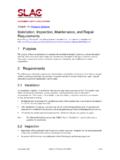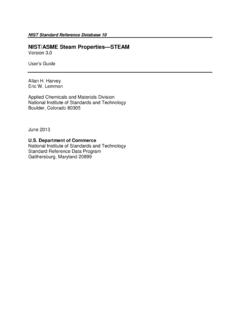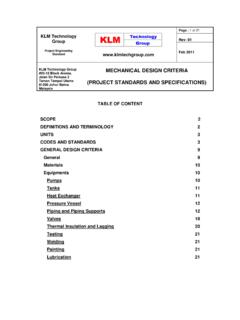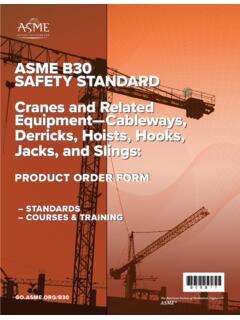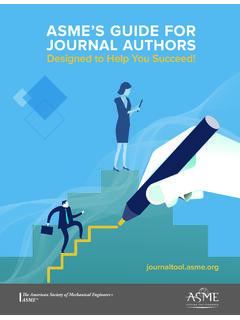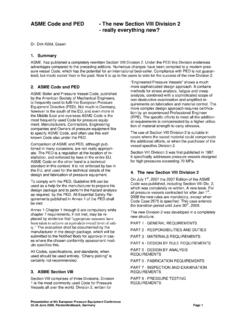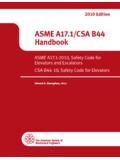Transcription of Technical Literature: ASTM A370 / ASME SA-370 Company ...
1 Standard Test Methods and Definitions forMechanical Testing of Steel Products1 This standard is issued under the fixed designation A370; the number immediately following the designation indicates the year oforiginal adoption or, in the case of revision, the year of last revision. A number in parentheses indicates the year of last reapproval. Asuperscript epsilon ( ) indicates an editorial change since the last revision or standard has been approved for use by agencies of the Department of Scope* These test methods2cover procedures and definitionsfor the mechanical testing of steels, stainless steels, and relatedalloys.
2 The various mechanical tests herein described are usedto determine properties required in the product in testing methods are to be avoided, and standardmethods of testing are to be followed to obtain reproducibleand comparable results. In those cases in which the testingrequirements for certain products are unique or at variance withthese general procedures, the product specification testingrequirements shall The following mechanical tests are Annexes covering details peculiar to certain productsare appended to these test methods as follows:AnnexBar ProductsAnnex A1 Tubular ProductsAnnex A2 FastenersAnnex A3 Round Wire ProductsAnnex A4 Significance of Notched-Bar Impact TestingAnnex A5 Converting Percentage Elongation of Round Specimens toEquivalents for Flat SpecimensAnnex A6 Testing Multi-Wire StrandAnnex A7 Rounding of Test DataAnnex A8 Methods for Testing Steel Reinforcing BarsAnnex A9 Procedure for Use and Control of Heat-Cycle SimulationAnnex The values stated in inch-pound units are to be regardedas the When this document is referenced in a metric productspecification.
3 The yield and tensile values may be determined ininch-pound (ksi) units then converted into SI (MPa) units. Theelongation determined in inch-pound gauge lengths of 2 or8 in. may be reported in SI unit gauge lengths of 50 or 200 mm,respectively, as applicable. Conversely, when this document isreferenced in an inch-pound product specification, the yieldand tensile values may be determined in SI units then con-verted into inch-pound units. The elongation determined in SIunit gauge lengths of 50 or 200 mm may be reported ininch-pound gauge lengths of 2 or 8 in., respectively, The specimen used to determine the original unitsmust conform to the applicable tolerances of the original unitsystem given in the dimension table not that of the convertedtolerance This is due to the specimen SI dimensions and tolerancesbeing hard conversions when this is not a dual standard.
4 The user isdirected to Test MethodsA1058if the tests are required in SI Attention is directed to ISO/IEC 17025 when there maybe a need for information on criteria for evaluation of standard does not purport to address all of thesafety concerns, if any, associated with its use. It is theresponsibility of the user of this standard to establish appro-priate safety and health practices and determine the applica-bility of regulatory limitations prior to Referenced Standards:3A623 Specification for Tin Mill Products, General Require-mentsA623 MSpecification for Tin Mill Products, General Re-quirements [Metric]A833 Practice for Indentation Hardness of Metallic Materi-als by Comparison Hardness TestersA956 Test Method for Leeb Hardness Testing of SteelProducts1 These test methods and definitions are under the jurisdiction of ASTMC ommitteeA01on Steel, Stainless Steel and Related Alloys and are the directresponsibility of Mechanical and Chemical Testing andProcessing Methods of Steel Products and edition approved May 1, 2016.
5 Published May 2016. Originallyapproved in 1953. Last previous edition approved in 2015 as A370 15. Boiler and Pressure Vessel Codeapplications see related Specifi-cation SA-370 in Section II of that referenced ASTM standards, visit the ASTM website, , orcontact ASTM Customer Service at ForAnnual Book of ASTMS tandardsvolume information, refer to the standard s Document Summary page onthe ASTM website.*A Summary of Changes section appears at the end of this standardCopyright ASTM International, 100 Barr Harbor Drive, PO Box C700, West Conshohocken, PA 19428-2959.
6 United States1 Technical Literature: ASTM A370 / asme SA-370 Company Website: Reliable Supplier of ferrous & nonferrous piping materials!A1038 Test Method for Portable Hardness Testing by theUltrasonic Contact Impedance MethodA1058 Test Methods for Mechanical Testing of SteelProducts MetricA1061/A1061 MTest Methods for Testing Multi-Wire SteelPrestressing StrandE4 Practices for Force Verification of Testing MachinesE6 Terminology Relating to Methods of Mechanical TestingE8/E8 MTest Methods for Tension Testing of Metallic Ma-terialsE10 Test Method for Brinell Hardness of Metallic MaterialsE18 Test Methods for Rockwell Hardness of Metallic Ma-terialsE23 Test Methods for Notched Bar Impact
7 Testing of Me-tallic MaterialsE29 Practice for Using Significant Digits in Test Data toDetermine Conformance with SpecificationsE83 Practice for Verification and Classification of Exten-someter SystemsE110 Test Method for Rockwell and Brinell Hardness ofMetallic Materials by Portable Hardness TestersE190 Test Method for Guided Bend Test for Ductility ofWeldsE290 Test Methods for Bend Testing of Material for Document:4 asme Boiler and Pressure Vessel Code,Section VIII,Division I, Part Standard:5 ISO/IEC 17025 General Requirements for the Competenceof Testing and Calibration Laboratories3.
8 Significance and The primary use of these test methods is testing todetermine the specified mechanical properties of steel, stainlesssteel and related alloy products for the evaluation of confor-mance of such products to a material specification under thejurisdiction of ASTM CommitteeA01and its subcommitteesas designated by a purchaser in a purchase order or These test methods may be and are used by otherASTM Committees and other standards writing bodies for thepurpose of conformance The material condition at the time of testing, samplingfrequency, specimen location and orientation, reportingrequirements, and other test parameters are contained in thepertinent material specification or in a General RequirementSpecification for the particular product Some material specifications require the use of addi-tional test methods not described herein.
9 In such cases, therequired test method is described in that material specificationor by reference to another appropriate test method These test methods are also suitable to be used fortesting of steel, stainless steel and related alloy materials forother purposes, such as incoming material acceptance testingby the purchaser or evaluation of components after As with any mechanical testing, deviations from eitherspecification limits or expected as-manufactured properties canoccur for valid reasons besides deficiency of the originalas-fabricated product. These reasons include, but are notlimited to: subsequent service degradation from environmentalexposure (for example, temperature, corrosion); static or cyclicservice stress effects, mechanically-induced damage, materialinhomogeneity, anisotropic structure, natural aging of selectalloys, further processing not included in the specification,sampling limitations, and measuring equipment calibrationuncertainty.
10 There is statistical variation in all aspects ofmechanical testing and variations in test results from prior testsare expected. An understanding of possible reasons for devia-tion from specified or expected test values should be applied ininterpretation of test General Certain methods of fabrication, such as bending,forming, and welding, or operations involving heating, mayaffect the properties of the material under test. Therefore, theproduct specifications cover the stage of manufacture at whichmechanical testing is to be performed. The properties shown bytesting prior to fabrication may not necessarily be representa-tive of the product after it has been completely Improperly machined specimens should be discardedand other specimens Flaws in the specimen may also affect results.



